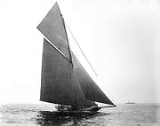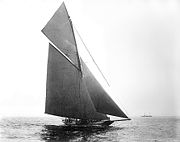
John S. Johnston
Encyclopedia

Landscape
Landscape comprises the visible features of an area of land, including the physical elements of landforms such as mountains, hills, water bodies such as rivers, lakes, ponds and the sea, living elements of land cover including indigenous vegetation, human elements including different forms of...
photographer. He is known for his photographs of racing yachts and New York City
New York City
New York is the most populous city in the United States and the center of the New York Metropolitan Area, one of the most populous metropolitan areas in the world. New York exerts a significant impact upon global commerce, finance, media, art, fashion, research, technology, education, and...
landmarks and cityscapes.
Very little is known about his life. He was evidently born in Britain in the late 1830s, and was active in the New York City area in the late 1880s and 1890s. He died in 1899.
Johnston's photographs were published in Outing magazine, Forest and Stream (now Field and Stream), and other 1890s periodicals featuring yacht racing
Yacht racing
Yacht racing is the sport of competitive yachting.While sailing groups organize the most active and popular competitive yachting, other boating events are also held world-wide: speed motorboat racing; competitive canoeing, kayaking, and rowing; model yachting; and navigational contests Yacht racing...
.
Collections of Johnston's work exist today at the Mystic Seaport
Mystic Seaport
Mystic Seaport, the Museum of America and the Sea, in Mystic, Connecticut, is notable both for its collection of sailing ships and boats, and for the re-creation of crafts and fabric of an entire 19th century seafaring village...
Museum, the Museum of the City of New York
Museum of the City of New York
The Museum of the City of New York is an art gallery and history museum founded in 1923 to present the history of New York City, USA and its people...
, the National Museum of American History
National Museum of American History
The National Museum of American History: Kenneth E. Behring Center collects, preserves and displays the heritage of the United States in the areas of social, political, cultural, scientific and military history. Among the items on display are the original Star-Spangled Banner and Archie Bunker's...
, the Hallmark Photographic Collection
Hallmark Photographic Collection
The Hallmark Photographic Collection was amassed by Hallmark Cards, Inc..It was donated to the Nelson-Atkins Museum of Art in Kansas City, Missouri in December 2005...
, the Metropolitan Museum of Art
Metropolitan Museum of Art
The Metropolitan Museum of Art is a renowned art museum in New York City. Its permanent collection contains more than two million works, divided into nineteen curatorial departments. The main building, located on the eastern edge of Central Park along Manhattan's Museum Mile, is one of the...
, the New York Public Library
New York Public Library
The New York Public Library is the largest public library in North America and is one of the United States' most significant research libraries...
, the Seattle Art Museum
Seattle Art Museum
The Seattle Art Museum is an art museum located in Seattle, Washington, USA. It maintains three major facilities: its main museum in downtown Seattle; the Seattle Asian Art Museum in Volunteer Park on Capitol Hill, and the Olympic Sculpture Park on the central Seattle waterfront, which opened on...
, and many other museums and archives across the United States.
Johnston was also an active canoeist. According to Forest and Stream magazine, he was "one of the old-time disciples of MacGregor
John MacGregor (sportsman)
John MacGregor , nicknamed Rob Roy after a renowned relative, was a Scottish explorer, travel writer and philanthropist. He is generally credited with the development of the first sailing canoes and with popularising canoeing as a middle class sport in Europe and the United States...
; taking up canoeing as a boy in England when the sport was still a novelty."
He reportedly worked in partnership with C. Miller at one time, and his office was located at various times on 508 W. 158th Street as well as 494 W. 166th St. & 783 Broadway in New York City.
His obituary appears on page ten of the December 19, 1899 edition of the New York Times:
"DIES TRYING TO HIDE IDENTITY.
J. S. Johnston of New York Refuses to Reveal His Friends' Names.
BUFFALO, Dec. 18 [1899]. --- J. S. Johnston, a photographer at 1263 Broadway, New York, died at Niagara FallsNiagara FallsThe Niagara Falls, located on the Niagara River draining Lake Erie into Lake Ontario, is the collective name for the Horseshoe Falls and the adjacent American Falls along with the comparatively small Bridal Veil Falls, which combined form the highest flow rate of any waterfalls in the world and has...
yesterday of heart trouble. Mr. Johnston would not give his home address or the names of any friends in New York, even when he was told that his death was near.
John S. Johnston made a specialty of scenic photography. He photographed most of the United States warships during the war with SpainSpanish-American WarThe Spanish–American War was a conflict in 1898 between Spain and the United States, effectively the result of American intervention in the ongoing Cuban War of Independence...
. He also photographed all of the international yacht races during the past ten years. It was while taking photographs of the ColumbiaColumbia (1899 yacht)Columbia was the defender of the tenth America's Cup race in 1899 against British challenger Shamrock as well as the defender of the eleventh America's Cup race in 1901 against British challenger, Shamrock II...
-ShamrockShamrock (yacht)Shamrock was the unsuccessful Irish challenger for the 10th America's Cup in 1899 against the United States defender, Columbia.-Design:Shamrock was designed by third-generation Scottish boatbuilder, William Fife III, Jr., and built in 1898 by J...
races that he caught a severe cold, on account of which he left town last Tuesday for Niagara Falls, to benefit his health.
Very little of his history is known. His home was at 464 West One Hundred and Sixty-sixth Street, where he lived alone. It is said that he was a native of Ireland and about sixty years old; that he was married and had a grown daughter, but had been separated from his family for some time."

